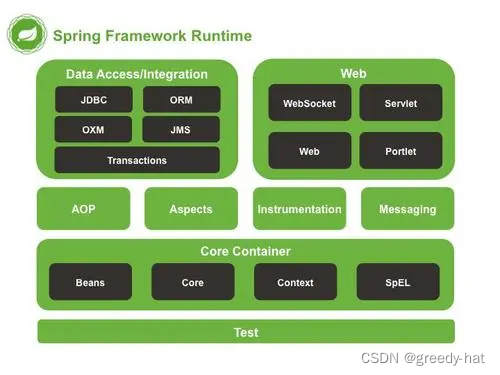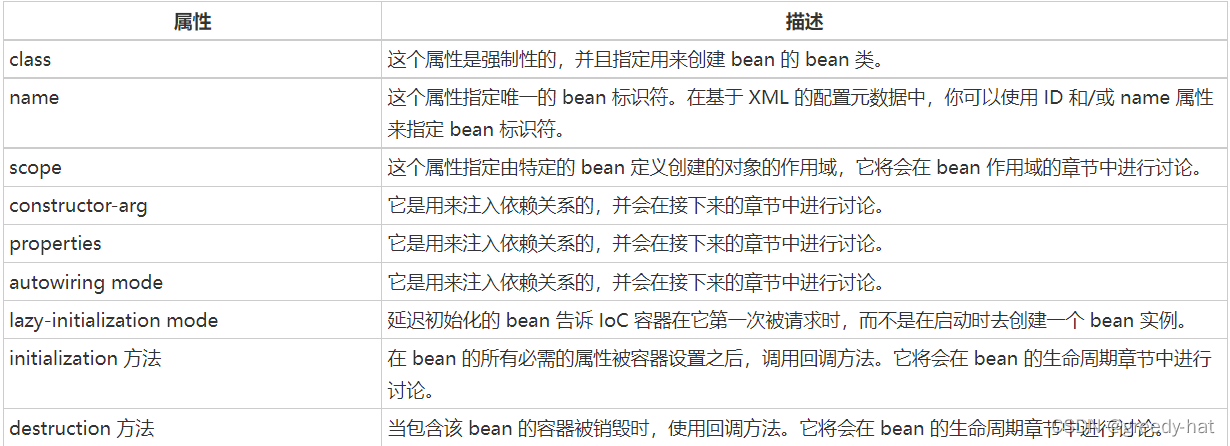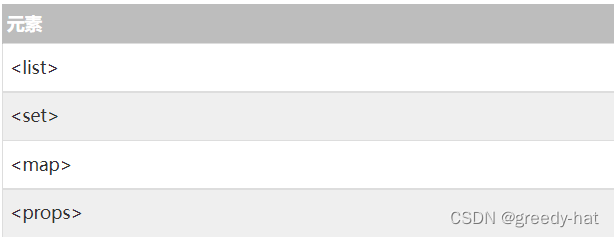Spring 体系结构

核心容器(Core Container)
核心容器由 spring-core,spring-beans,spring-context和spring-expression(SpEL,Spring 表达式语言,Spring Expression Language)等模块组成,它们的细节如下:
- spring-core 模块提供了框架的基本组成部分,包括 IoC 和依赖注入功能。
- spring-beans 模块提供 BeanFactory,工厂模式的微妙实现,它移除了编码式单例的需要,并且可以把配置和依赖从实际编码逻辑中解耦。
- context 模块建立在由 core和 beans 模块的基础上建立起来的,它以一种类似于 JNDI 注册的方式访问对象。
Context 模块继承自 Bean 模块,并且添加了国际化、事件传播、资源加载和透明地创建上下文等功能。Context 模块也支持 Java EE 的功能,比如 EJB、JMX 和远程调用等。 - spring-context-support 提供了对第三方集成到 Spring-context的支持,比如缓存(EhCache, Guava, JCache)、邮件(JavaMail)、调度(CommonJ,Quartz)、模板引擎(FreeMarker, JasperReports, Velocity)等。
- spring-expression 模块提供了强大的表达式语言,用于在运行时查询和操作对象。它是 JSP2.1 规范中定义的统一表达式语言的扩展,支持 set 和 get 属性值、属性赋值、方法调用、访问数组集合及索引的内容、逻辑算术运算、命名变量、通过名字从 Spring IoC 容器检索对象,还支持列表的投影、选择以及聚合等。
数据访问/集成(Data Access/Integration)
数据访问/集成层包括 JDBC,ORM,OXM,JMS 和事务处理模块,它们的细节如下:
注:
JDBC=Java Data Base Connectivity
ORM=Object RelationalMapping
OXM=Object XML Mapping
JMS=Java Message Service
- JDBC 模块提供了 JDBC 抽象层,它消除了冗长的 JDBC 编码和对数据库供应商特定错误代码的解析。
- ORM 模块提供了对流行的对象关系映射 API 的集成,包括 JPA、JDO 和 Hibernate 等。通过此模块可以让这些 ORM 框架和 spring的其它功能整合,比如前面提及的事务管理。
- OXM 模块提供了对 OXM 实现的支持,比如 JAXB、Castor、XML Beans、JiBX、XStream 等。
- JMS 模块包含生产(produce)和消费(consume)消息的功能。从 Spring 4.1 开始,集成了 spring-messaging 模块。
- 事务模块为实现特殊接口类及所有的 POJO 支持编程式和声明式事务管理。(注:编程式事务需要自己写 beginTransaction()、commit()、rollback() 等事务管理方法,声明式事务是通过注解或配置由 spring 自动处理,编程式事务粒度更细)
Web
Web 层由 Web,Web-MVC,Web-Socket 和 Web-Portlet 组成,它们的细节如下:
-
Web 模块提供面向 web 的基本功能和面向 web 的应用上下文,比如多部分(multipart)文件上传功能、使用 Servlet 监听器初始化 IoC 容器等。它还包括 HTTP 客户端以及 Spring 远程调用中与 web 相关的部分。
-
Web-MVC 模块为 web 应用提供了模型视图控制(MVC)和 REST Web服务的实现。Spring 的 MVC 框架可以使领域模型代码和 web 表单完全地分离,且可以与 Spring 框架的其它所有功能进行集成。
-
Web-Socket 模块为 WebSocket-based 提供了支持,而且在 web 应用程序中提供了客户端和服务器端之间通信的两种方式。
-
Web-Portlet 模块提供了用于 Portlet 环境的 MVC 实现,并反映了 spring-webmvc 模块的功能。
Test
Test 模块:Spring 支持 Junit 和 TestNG 测试框架,而且还额外提供了一些基于 Spring 的测试功能,比如在测试 Web 框架时,模拟 Http 请求的功能。
其他
还有其他一些重要的模块,像 AOP,Aspects,Instrumentation,Messaging模块,它们的细节如下:
-
AOP 模块提供了面向方面(切面)的编程实现,允许你定义方法拦截器和切入点对代码进行干净地解耦,从而使实现功能的代码彻底的解耦出来。使用源码级的元数据,可以用类似于.Net属性的方式合并行为信息到代码中。
-
Aspects 模块提供了与 AspectJ 的集成,这是一个功能强大且成熟的面向切面编程(AOP)框架。
-
Instrumentation 模块在一定的应用服务器中提供了类 instrumentation 的支持和类加载器的实现。
-
Messaging 模块为 STOMP 提供了支持作为在应用程序中 WebSocket 子协议的使用。它也支持一个注解编程模型,它是为了选路和处理来自 WebSocket 客户端的 STOMP 信息。
Spring中IoC容器和依赖注入一起使用才能实现框架功能。
Spring IoC容器
IoC(Inversion of Control,控制反转)
Spring IoC容器是Spring的核心,一切Spring Bean都存储在Spring IoC容器内。
可以说Spring bean是Spring核心中的核心。
Spring Bean配置信息定义了Bean的实现及依赖关系,Spring IoC容器根据各种形式的Bean配置信息来创建Bean实例,并调用Bean实例的方法来完成“依赖注入”。
可以把Spring IoC容器理解成一个大型工厂,Spring Bean就是该工厂的产品,工厂(Spirng IoC容器)里能生产出来什么样的产品(Bean),完全取决于配置文件中的配置,而这个配置是由开发人员创建和维护的。
Spring Bean定义
Spring IoC 容器完全由实际编写的配置元数据的格式解耦。有下面三个重要的方法把配置元数据提供给 Spring 容器:
基于 XML 的配置文件
<?xml version="1.0" encoding="UTF-8"?>
<beans xmlns="http://www.springframework.org/schema/beans"
xmlns:xsi="http://www.w3.org/2001/XMLSchema-instance"
xsi:schemaLocation="http://www.springframework.org/schema/beans
http://www.springframework.org/schema/beans/spring-beans-3.0.xsd">
<!-- A simple bean definition -->
<bean id="..." class="...">
<!-- collaborators and configuration for this bean go here -->
</bean>
<!-- A bean definition with lazy init set on -->
<bean id="..." class="..." lazy-init="true">
<!-- collaborators and configuration for this bean go here -->
</bean>
<!-- A bean definition with initialization method -->
<bean id="..." class="..." init-method="...">
<!-- collaborators and configuration for this bean go here -->
</bean>
<!-- A bean definition with destruction method -->
<bean id="..." class="..." destroy-method="...">
<!-- collaborators and configuration for this bean go here -->
</bean>
<!-- more bean definitions go here -->
</beans>

基于注解的配置

基于 Java 的配置
Spring Bean作用域

Spring 依赖注入
DI(Dependency Injection,依赖注入)是实现控制反转的主要方式。
Spring 基于构造函数的依赖注入
<beans>
<bean id="exampleBean" class="examples.ExampleBean">
<constructor-arg type="int" value="2001"/>
<constructor-arg type="java.lang.String" value="Zara"/>
</bean>
</beans>
<beans>
<bean id="exampleBean" class="examples.ExampleBean">
<constructor-arg index="0" value="2001"/>
<constructor-arg index="1" value="Zara"/>
</bean>
</beans>
Spring 基于设值函数的依赖注入
<?xml version="1.0" encoding="UTF-8"?>
<beans xmlns="http://www.springframework.org/schema/beans"
xmlns:xsi="http://www.w3.org/2001/XMLSchema-instance"
xsi:schemaLocation="http://www.springframework.org/schema/beans
http://www.springframework.org/schema/beans/spring-beans-3.0.xsd">
<!-- Definition for textEditor bean -->
<bean id="textEditor" class="com.tutorialspoint.TextEditor">
<property name="spellChecker" ref="spellChecker"/>
</bean>
<!-- Definition for spellChecker bean -->
<bean id="spellChecker" class="com.tutorialspoint.SpellChecker">
</bean>
</beans>
如果你要把一个引用传递给一个对象,那么你需要使用标签的 ref 属性,而如果你要直接传递一个值,那么你应该使用 value 属性。
使用 p-namespace 实现 XML 配置:
如果你有许多的设值函数方法,那么在 XML 配置文件中使用 p-namespace 是非常方便的。
<?xml version="1.0" encoding="UTF-8"?>
<beans xmlns="http://www.springframework.org/schema/beans"
xmlns:xsi="http://www.w3.org/2001/XMLSchema-instance"
xsi:schemaLocation="http://www.springframework.org/schema/beans
http://www.springframework.org/schema/beans/spring-beans-3.0.xsd">
<bean id="john-classic" class="com.example.Person">
<property name="name" value="John Doe"/>
<property name="spouse" ref="jane"/>
</bean>
<bean name="jane" class="com.example.Person">
<property name="name" value="John Doe"/>
</bean>
</beans>
<?xml version="1.0" encoding="UTF-8"?>
<beans xmlns="http://www.springframework.org/schema/beans"
xmlns:xsi="http://www.w3.org/2001/XMLSchema-instance"
xmlns:p="http://www.springframework.org/schema/p"
xsi:schemaLocation="http://www.springframework.org/schema/beans
http://www.springframework.org/schema/beans/spring-beans-3.0.xsd">
<bean id="john-classic" class="com.example.Person"
p:name="John Doe"
p:spouse-ref="jane"/>
</bean>
<bean name="jane" class="com.example.Person"
p:name="John Doe"/>
</bean>
</beans>
Spring 注入集合

<?xml version="1.0" encoding="UTF-8"?>
<beans xmlns="http://www.springframework.org/schema/beans"
xmlns:xsi="http://www.w3.org/2001/XMLSchema-instance"
xsi:schemaLocation="http://www.springframework.org/schema/beans
http://www.springframework.org/schema/beans/spring-beans-3.0.xsd">
<!-- Definition for javaCollection -->
<bean id="javaCollection" class="com.tutorialspoint.JavaCollection">
<!-- results in a setAddressList(java.util.List) call -->
<property name="addressList">
<list>
<value>INDIA</value>
<value>Pakistan</value>
<value>USA</value>
<value>USA</value>
</list>
</property>
<!-- results in a setAddressSet(java.util.Set) call -->
<property name="addressSet">
<set>
<value>INDIA</value>
<value>Pakistan</value>
<value>USA</value>
<value>USA</value>
</set>
</property>
<!-- results in a setAddressMap(java.util.Map) call -->
<property name="addressMap">
<map>
<entry key="1" value="INDIA"/>
<entry key="2" value="Pakistan"/>
<entry key="3" value="USA"/>
<entry key="4" value="USA"/>
</map>
</property>
<!-- results in a setAddressProp(java.util.Properties) call -->
<property name="addressProp">
<props>
<prop key="one">INDIA</prop>
<prop key="two">Pakistan</prop>
<prop key="three">USA</prop>
<prop key="four">USA</prop>
</props>
</property>
</bean>
</beans>
Spring Beans自动装配
Spring 容器可以在不使用和 元素的情况下自动装配相互协作的 bean 之间的关系,这有助于减少编写一个大的基于 Spring 的应用程序的 XML 配置的数量。

byName
<?xml version="1.0" encoding="UTF-8"?>
<beans xmlns="http://www.springframework.org/schema/beans"
xmlns:xsi="http://www.w3.org/2001/XMLSchema-instance"
xsi:schemaLocation="http://www.springframework.org/schema/beans
http://www.springframework.org/schema/beans/spring-beans-3.0.xsd">
<!-- Definition for textEditor bean -->
<bean id="textEditor" class="com.tutorialspoint.TextEditor">
<property name="spellChecker" ref="spellChecker" />
<property name="name" value="Generic Text Editor" />
</bean>
<!-- Definition for spellChecker bean -->
<bean id="spellChecker" class="com.tutorialspoint.SpellChecker">
</bean>
</beans>
<?xml version="1.0" encoding="UTF-8"?>
<beans xmlns="http://www.springframework.org/schema/beans"
xmlns:xsi="http://www.w3.org/2001/XMLSchema-instance"
xsi:schemaLocation="http://www.springframework.org/schema/beans
http://www.springframework.org/schema/beans/spring-beans-3.0.xsd">
<!-- Definition for textEditor bean -->
<bean id="textEditor" class="com.tutorialspoint.TextEditor"
autowire="byName">
<property name="name" value="Generic Text Editor" />
</bean>
<!-- Definition for spellChecker bean -->
<bean id="spellChecker" class="com.tutorialspoint.SpellChecker">
</bean>
</beans>
<?xml version="1.0" encoding="UTF-8"?>
<beans xmlns="http://www.springframework.org/schema/beans"
xmlns:xsi="http://www.w3.org/2001/XMLSchema-instance"
xsi:schemaLocation="http://www.springframework.org/schema/beans
http://www.springframework.org/schema/beans/spring-beans-3.0.xsd">
<!-- Definition for textEditor bean -->
<bean id="textEditor" class="com.tutorialspoint.TextEditor">
<property name="spellChecker" ref="spellChecker" />
<property name="name" value="Generic Text Editor" />
</bean>
<!-- Definition for spellChecker bean -->
<bean id="spellChecker" class="com.tutorialspoint.SpellChecker">
</bean>
</beans>
byType
<?xml version="1.0" encoding="UTF-8"?>
<beans xmlns="http://www.springframework.org/schema/beans"
xmlns:xsi="http://www.w3.org/2001/XMLSchema-instance"
xsi:schemaLocation="http://www.springframework.org/schema/beans
http://www.springframework.org/schema/beans/spring-beans-3.0.xsd">
<!-- Definition for textEditor bean -->
<bean id="textEditor" class="com.tutorialspoint.TextEditor">
<property name="spellChecker" ref="spellChecker" />
<property name="name" value="Generic Text Editor" />
</bean>
<!-- Definition for spellChecker bean -->
<bean id="spellChecker" class="com.tutorialspoint.SpellChecker">
</bean>
</beans>
<?xml version="1.0" encoding="UTF-8"?>
<beans xmlns="http://www.springframework.org/schema/beans"
xmlns:xsi="http://www.w3.org/2001/XMLSchema-instance"
xsi:schemaLocation="http://www.springframework.org/schema/beans
http://www.springframework.org/schema/beans/spring-beans-3.0.xsd">
<!-- Definition for textEditor bean -->
<bean id="textEditor" class="com.tutorialspoint.TextEditor"
autowire="byType">
<property name="name" value="Generic Text Editor" />
</bean>
<!-- Definition for spellChecker bean -->
<bean id="SpellChecker" class="com.tutorialspoint.SpellChecker">
</bean>
</beans>
Spring AOP
AOP(Aspect Oriented Programming,面向切面编程)
项目中用到AOP的两个地方,一个是某些地方需要记录日志,例如某些方法在执行完希望记录日志。另外就是读和谐数据源的注入。因为一般项目都会采取读写分离,所以根据方法名称的一些规则注入不同的数据源。例如read开头的方法,注入读的数据源,update开头的方法,注入写数据源。
代理模式
静态代理(编译期代理),动态代理(运行时代理)